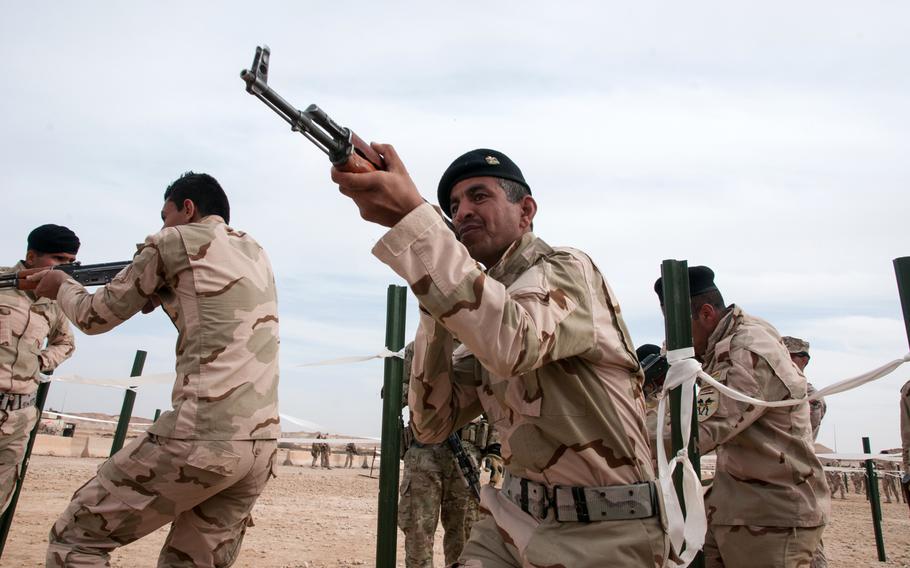
In this file photo from Feb. 10, 2015, a member of an Iraqi infantry squad enters through a simulated doorway to clear a room during a training exercise at Al Asad Air Base, Iraq. (Mike Lavigne/U.S. Army)
WASHINGTON — Islamic State militants on Friday penetrated the perimeter of an Iraqi base where about 400 U.S. troops are stationed, according to military officials.
The latest reports from the field suggest that 20 to 25 insurgents attacked Iraqi army facility at the Al Asad Air Base in Anbar province, Pentagon press secretary Rear Adm. John Kirby told reporters Friday afternoon.
Kirby said the attack was initiated by “at least several suicide attackers,” some of whom detonated their bomb vests and blew themselves up. That initial wave was followed by about 15 additional fighters.
Kirby said initial indications are that most, if not all, of the attackers were wearing Iraqi army uniforms.
Australian army Maj. Sarah Hawke, a spokeswoman for Combined Joint Task Force-Operation Inherent Resolve, said that some militants penetrated the perimeter of the base.
“The Iraqi Security Forces (ISF) supported by Coalition surveillance assets defeated the attack” and “the ISF have since re-secured their facility,” CJTF-OIR said in a statement Friday morning.
Officials said that coalition forces were not directly involved in the counterattack. Their contribution was limited to aerial surveillance to assist the Iraqi security forces.
“The attack failed. Most of the attackers were killed by Iraqi Security Forces. Some of them, they blew themselves up,” Kirby said.
Kirby would not rule out the possibility that some of the Islamic State fighters might have survived, saying “I don't have an exact nose-count on every one of them.”
He said there are no indications at this point of any ISF casualties, and there were definitely no coalition casualties.
“Coalition forces were several kilometers from the attack and at no stage where they under direct threat from this action,” CJTF-OIR said in the statement.
Kirby emphasized the geography of Al Asad.
“It is a big, sprawling facility,” he said. “It's basically a base of many, many bases inside. And at no time were U.S. troops anywhere near the fighting. [They were] at least a couple of miles away. They might've heard shots being fired, but that would've been about it.”
Earlier Friday, a statement by CJTF-OIR, said that eight insurgents had attacked the facility and been killed. Kirby noted that information is still coming in about the attack, and the numbers being reported could change.
Friday’s attack isn’t the first time that Al Asad has come under insurgent fire. For months, the Islamic State has been regularly launching small-scale rocket and mortar attacks on the facility.
The base “has been subjected to ineffective indirect fires … on average several times per week for several months now,” Pentagon spokesman Col. Steve Warren told reporters Thursday
“Thus far, none of the indirect fire attacks that have been launched against it have had any impact at all — no American casualties, no American equipment damaged.”
There are about 400 American troops at Al Asad training and advising ISF forces, who are battling the Islamic State in Anbar and across Iraq. In total, there are approximately 2,600 U.S. servicemembers in country.
President Barack Obama has ruled out sending American ground forces into combat in Iraq, and the administration’s strategy for defeating the Islamic State relies heavily on local forces to retake captured territory.
The U.S. military plans to train nine ISF brigades and three peshmerga brigades at four training locations throughout Iraq. Iraqi forces are expected to launch major offensives to retake key terrain, perhaps as early as this spring.
Kirby was asked whether additional force protection measures need to be put in place to keep American troops safe
“The commander on the ground gets to make those decisions, and I don't believe that [CJTF-OIR commander Army Lt. Gen. James Terry] has made any adjustments as a result of this. He very well might. We'll just have to wait and see,” Kirby said.
Although U.S. troops are in Iraq in a non-combat role, they are allowed to defend themselves if they come under attack.
“They're trained and capable of doing that,” Kirby said. “Our full expectation would be that if they come under fire, they will shoot back.”
harper.jon@stripes.com Twitter: @JHarperStripes